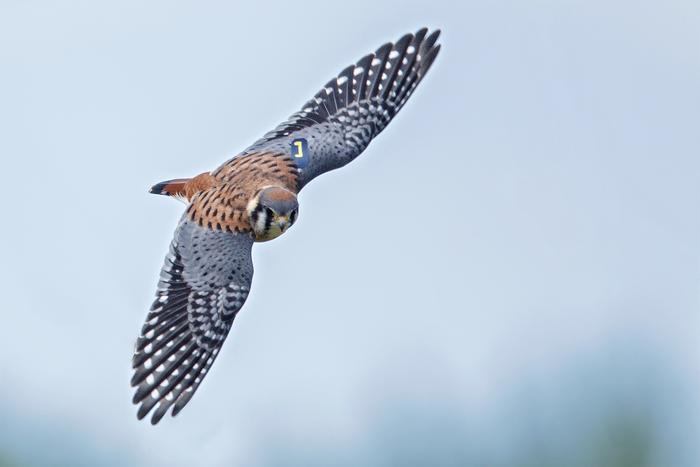The American Kestrel, a colorful and charismatic falcon, has kept researchers scratching their heads for years. Population declines are confirmed across North America, but who or what to blame has remained elusive. A new paper, “Evidence of Continuing Downward Trends in American Kestrel Populations and Recommendations for Research Into Causal Factors,” published in the Journal of Raptor Research, provides needed updates on the status of kestrel populations at the regional scale, and offers a comprehensive discussion on the potential causes for the species’ decline. Importantly, the authors point out that kestrels could be experiencing trouble outside of the breeding season, a part of their annual cycle that is arguable understudied. This paper provides an updated common ground for raptor researchers through which they can streamline study priorities, an important recalibration if this beloved falcon is to remain numerous in our skies.

Credit: Photo by Herb Houghton.
The American Kestrel, a colorful and charismatic falcon, has kept researchers scratching their heads for years. Population declines are confirmed across North America, but who or what to blame has remained elusive. A new paper, “Evidence of Continuing Downward Trends in American Kestrel Populations and Recommendations for Research Into Causal Factors,” published in the Journal of Raptor Research, provides needed updates on the status of kestrel populations at the regional scale, and offers a comprehensive discussion on the potential causes for the species’ decline. Importantly, the authors point out that kestrels could be experiencing trouble outside of the breeding season, a part of their annual cycle that is arguable understudied. This paper provides an updated common ground for raptor researchers through which they can streamline study priorities, an important recalibration if this beloved falcon is to remain numerous in our skies.
Authors David M. Bird and John A. Smallwood posit that multiple factors are likely causing kestrel declines, evidenced by the fact that, while many populations are declining, some are rebounding or stabilizing. Not all kestrels are encountering the same challenges. Bird and Smallwood present essential research pathways moving forward, including: investigating the impact of Cooper’s Hawks on kestrel distributions and survival, assessing habitat degradation on the kestrel’s wintering grounds (which often fall outside of U.S. borders), looking at fine-scale changes in habitat quality on the breeding grounds, examining the impacts of climate change on the availability of prey species for kestrels, determining how important grasshoppers are as a prey species, and studying the impacts of rodenticides and pesticides on the health of kestrel populations.
Not only are focused research recommendations put forth in this paper, but several theories about the kestrel decline are put to rest. West Nile virus and competition for nesting cavities from European starlings are no longer considered significant threats to kestrel success.
Raptors serve as bioindicators, meaning they shed light on the overall health of the ecosystems in which they reside. The American kestrel is no exception. To support these birds in their quest for survival is to support environmental health across North America, and this is not just a cause for experts. Citizen scientists collect essential data on various aspects of the kestrel picture by participating in projects like the Breeding Bird Survey. Without public participation our understanding of this species’ decline would be far less comprehensive.
Proof of this lies in the study design of Bird and Smallwood’s work. They analyzed four types of data that spanned between 38 and 55 years and depended on the participation of citizen scientists: the Breeding Bird Survey, Christmas Bird Count, migration data from two sites located along flyways in the east, and nest box monitoring programs. The latter, according to Smallwood, “has generated an invaluable database that allows us to examine not only population trends but also lots of aspects of kestrel behavior and ecology.”
Notably, Breeding Bird Surveys revealed that kestrel declines have been observed in 23 of 25 bird conservation regions, with the mid-Atlantic seeing the worst of it. Surveys across Canada also showed high rates of decline. Population increases occurred in only 3 of these conservation regions, including the Chihuahuan Desert. The author’s further assessment of these trends suggests that the magnitude of decline may be lessening, meaning the declines are real, but that extinction is not the only possible outcome. We may just see fewer and fewer kestrels, until we consistently see few — a quieter, blander, sparsely-falconed landscape.
Smallwood and Bird bring to light the nuanced reality of conservation by showing just how interwoven threats to wildlife can be. This assessment of casual factors in the American kestrel’s decline illustrates that human activities are making life difficult for this beloved falcon, yet no one issue is to blame. “That the population has experienced such a marked decline should be a wake-up call,” says Smallwood. “Something is out of kilter across North American ecosystems and the problem could be much more widespread than for just this remarkable species.”
###
Paper
Bird, M. David and Smallwood, A. John (2023). Evidence of Continuing Downward Trends in American Kestrel Populations and Recommendations for Research Into Causal Factors. Journal of Raptor Research, 57(2):000-000.
Notes to Editor:
1. The Journal of Raptor Research (JRR) is an international scientific journal dedicated entirely to the dissemination of information about birds of prey. Established in 1967, JRR has published peer-reviewed research on raptor ecology, behavior, life history, conservation, and techniques. JRR is available quarterly to members in electronic and paper format.
2. The Raptor Research Foundation (RRF) is the world’s largest professional society for raptor researchers and conservationists. Founded in 1966 as a non-profit organization, our primary goal is the accumulation and dissemination of scientific information about raptors. The Foundation organizes annual scientific conferences and provides competitive grants & awards for student researchers & conservationists. The Foundation also provides support & networking opportunities for students & early career raptor researchers.
Journal
Journal of Raptor Research
DOI
10.3356/JRR-22-35
Method of Research
Data/statistical analysis
Subject of Research
Animals
Article Title
Evidence of Continuing Downward Trends in American Kestrel Populations and Recommendations for Research into Causal Factors
Article Publication Date
24-Apr-2023





